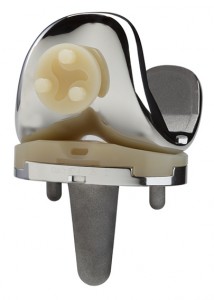![]()
E-MAX Highly Crosslinked Polyethylene (XLPE) for knee bearings builds on the successes of first generation XLPE by incorporating two innovative technologies: Vitamin E and mechanical annealing.

- Vitamin E is added to hinder in vivo oxidation, which can cause degradation of the polymer material. [1,2]
- Mechanically annealing—as opposed to melting—helps maintain mechanical properties. [3,4,5]
Thus, E-MAX Highly Crosslinked Polyethylene provides excellent wear properties [6], like first generation XLPE, plus oxidative stability and the improved mechanical properties needed in knee applications.
- Wannomae KK, Micheli BR, Lozynsky AJ, Muratoglu OK. A New Method of Stabilizing Irradiated UHMWPE Using Vitamin E and Mechanical Annealing. 11th Congress EFFORT. Madrid, Spain. June 2010.
- Costa L, Bracco P. Chapter 21 Mechanisms of crosslinking, oxidative degradation, and stabilization of UHMWPE. In UHMWPE Biomaterials Handbook Second Edition (ed. Kurtz SM). Elsevier: Amsterdam, 2009.
- Bhattacharyya S, Matrisciano L, Spiegelberg S, Harris W, Muratoglu O. Mechanical elimination of residual free radicals in an irradiated UHMWPE rod: advantages over melting. 50th annual meeting of the orthopaedic research society. 2004:1474.
- Gomez-Barrena E, Medel F, Puertolas JA. Polyethylene oxidation in total hip arthroplasty: evolution and new advances. The Open Orthopedics Journal 2009; 3:115-120.
- Materials Characterization testing. Test report TP0322. On file with KYOCERA Medical Technologies, Inc.
- University of Nebraska Medical Center. Characterization of CIMA and E-CIMA UHMWPE as a bearing against CoCr femoral hip components: A hip simulation study. Test report dated July 15, 2011. On file with KYOCERA Medical Technologies, Inc.